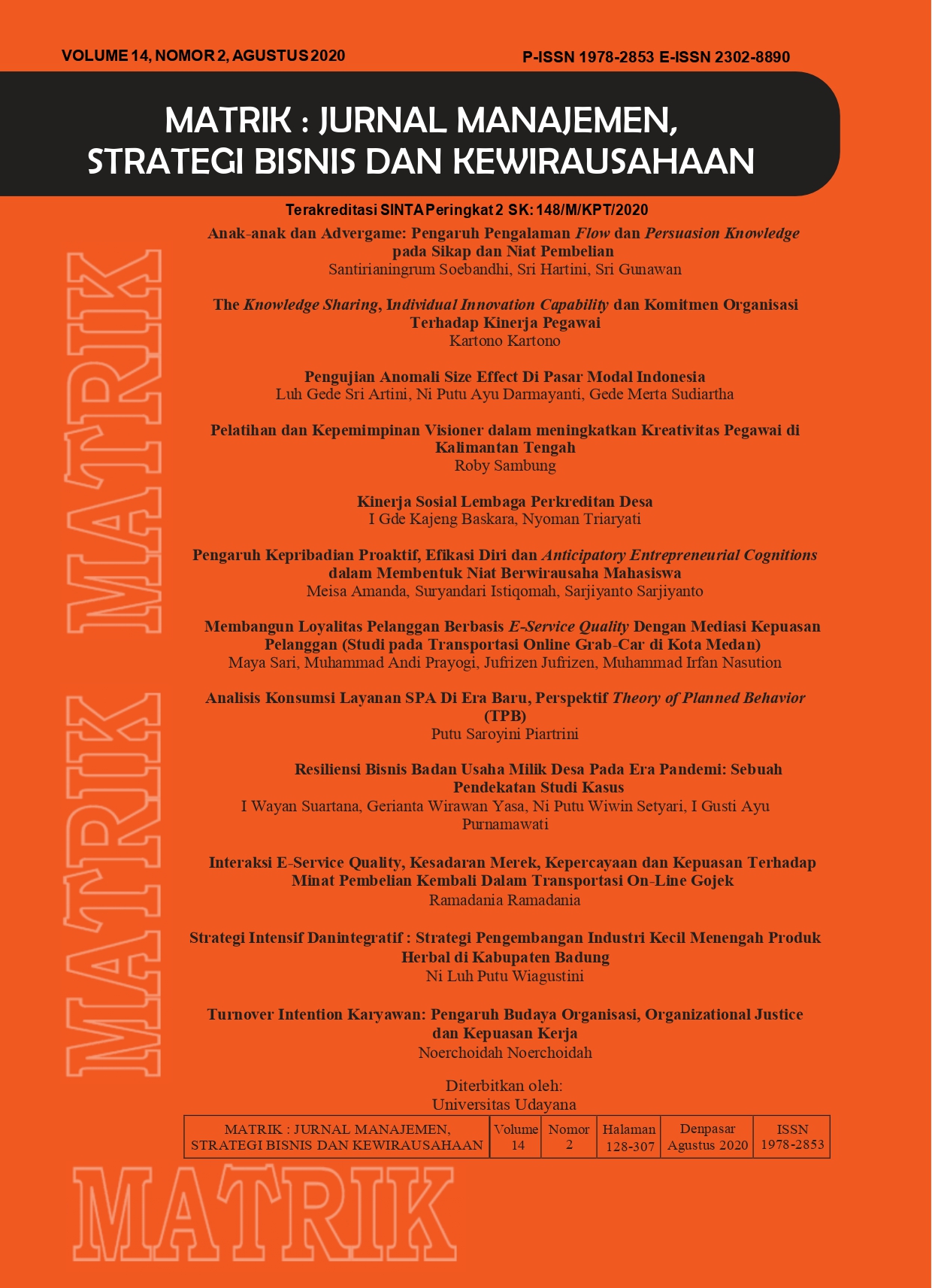Pengujian Anomali Size Effect Di Pasar Modal Indonesia
Abstract
The research on the size effect anomaly in the Indonesian Capital Market aims to find out the effect of company size on the performance of the stock portfolio. Descriptive statistical analysis method is used to explain the distribution of data and independent sample tests to compare the performance of stock portfolios of Sharpe index of large-size stock portfolios and small size stock portfolios formed from stocks that is consistently included in the Compass Index 100 during 2012-2017. The results of the study show that the Sharpe index of large-size stock portfolios is better than the small-size stock portfolio. The results of different tests show that the mean difference is not significant, so it can be concluded that the anomaly size effect does not occur in the Indonesian Capital Market, especially in stocks listed on the Kompas 100 Index
Downloads
References
Ardiana, Agus. (2016). Investasi Saham. Hibah Buku Ajar Jurusan Akuntansi FEB Unud.
Balakrishnan & Moinak Maiti. (2015). Performance of Micro Stocks in Indian Stock Market, Journal of Contemporary Research in Management, 10 (3), 45-50.
Banz, Rolf W. (1981). The Relationship Between Return and Market Value of Cammon Stocks. Journal of FinancialEconomics, 9 (1), 3-18
Boamah, Nicholas Addai. (2015). Robustness of the Carhart Four-Factor and the Fama-French Three-Factor Models on the South African Stock Market, Journal of Accounting and Finance, 14 (4), 413-430.
Dewi, Kartika & Luh Gede Sri Artini. (2014). Pengujian Efisiensi Pasar Bentuk Setengah Kuat, E-Jurnal Manajemen Unud, 3 (12), 3540-3557.
Dwipayana, Putra & I Gusti Bagus Wiksuana. (2017). Pengujian Efisiensi Pasar di Bursa Efek Indonesia, E-Jurnal Manajemen Unud, 6 (4), 2105-2132.
Eraslan, Veysel. (2013). Fama and French Three-Factor Model: Evidence from Istanbul Stock Exchange, Business and Economics Research Journal, 4 (2), 11-22.
Haq, Ikram ul and Kashif Rashid (2014). Stock Market Efficiency and Size of the Firm: Empirical Evidence from Pakistan, Economics of Knowledge, 6 (1), 10-31.
Hartono, Jogiyanto. (2017). Teori Portofolio dan Analisis Investasi(Edisi Sebelas). Yogyakarta:BPFE
Hwang, Tienyu, Simon Gao, & Heather Owen. (2013). Markowitz Efficiency and Size Effect: Evidence from the UK Stock Market, Journal of Quantitative Finance and Accounting, 43 (40), 721-750.
Jones, Charles P. (2014). Investments Principles and Concepts (Twelfth Edition).Singapore: John Wiley & Sons Singapore Pte, Ltd.
Kurniawan, Suryo & Anom Purbawangsa. (2018). Pengujian Anomali Pasar Size Effect dan The Day of Week Effect di Bursa Efek Indonesia. E-Jurnal Ekonomi dan Bisnis Universitas Udayana, 7 (9), 2147-2174.
Mazviona, Batsirai Winmore & Davis Nyangara. (2014). Does Firm Size Affect Stock Returns? Evidence from the Zimbabwe Stock Exchange, International Journal of Business and Economic Development (IJBED), 2 (3), 13-17.
Mikhael, Yan Pleti & Widanaputra. (2018). Pengujian Anomali Pasar Size Effect pada Bulan Januari di Pasar Modal Indonesia Tahun 2012-2015. E-Jurnal Akuntansi Universitas Udayana, 24 (1), 559-577
Nartea, Gilbert V, Bert D. Ward, & Hadrian G. Djajadikerta. (2009). Size, BM, and Momentum Effects and the Robustness of the Fama-French Three-Factor Model Evidence from New Zealand,International Journal of Managerial Finance, 5 (2), 179-200.
Octavio, Danes Quirira& Nuka Lantara. (2014). Market Overaction, Size Effect atau Liquidity Effect? Studi pada Bursa Efek Indonesia, Jurnal Manajemen Strategi Bisnis dan Kewirausahaan, 8 (1), 11-17.
Pandey, Asheesh & Sanjay Sehgal. (2015). Explaining Size Effect for Indian Stock Market, Journal of Financial Studies, 23 (5), 45-68.
PT Kustodian Sentral Efek Indonesia. (2017). KSEI Terus Upayakan Kemudahaan Pembukaan Rekening Investasi. Diunduh dari Kustodian Sentral Efek Indonesiawebsite:http://www.ksei.co.id/files/uploads/press_
releases/press_file/idid/135_berita_pers_ksei_terus_upayakan_kemudah_pembukaan_rekening_investasi_20170816154208.pdf.
Razak, Abdul, Jaafar Pyeman, & Wan Mansor Wan Mahmood. (2011). A Quest for Small-Firm Effect: Evidence from KLSE Second Board, Journal of Financial Economic, 9 (3), 28-39
Rutledge, Robert W, Zhaohui Zhang, & Khondkar Karim. (2008). Is There a Size Effect in the Pricing of Stocks in the Chinese Stock Markets?: The Case of Bull Versus Bear Markets, Journal of Managerial Finance, 15 (2), 117-133.
Saputro, R. Narendra & Ida Bagus Badjra. (2016). Kinerja Portofolio saham Berdasarkan Strategi Investasi Momentum Pada Industri Manufaktur, E-Jurnal Manajemen Unud, 5 (1), 623-649.
Sehgal, Sanjay & Balakrishnan. (2013). Robustness of Fama-French Three Factor Model: Further Evidence for Indian Stock Market, Journal of Management, 17 (2), 119-127.
Simlai, Pradosh. (2009). Stock Returns, Size, and Book-to-market Equity, Journal in Economics and Finance, 26 (3), 198-212.
Sobti, Neharika. (2018). Does Size, Value and Seasonal Effects Still Persist in Indian Equity Markets?, Journal of Financial Studies, 22 (1), 11-21.
Tandelilin, Eduardus. (2010). Portofolio dan Investasi(Edisi Pertama). Yogyakarta: Kanisius
Washer, Kenneth M, Srinivas Nippani, & Robert R. Johnson. (2016). Santa Claus Rally and Firm Size, Journal of Managerial Finance, 42 (8), 817-829.
Yani, Aulia Rahma. (2014). January Effect dan Size Effect,Jurnal Manajemen Strategi Bisnis dan Kewirausahaan,4 (2), 13-30
Yanuarta, Ramael. (2012). Anomali Size Effect di Bursa Efek Indonesia. Jurnal Kajian Manajemen Bisnis Universitas Negeri Padang, 1 (1), 39-58.
 This work is licensed under a Creative Commons Attribution-ShareAlike 4.0 International License.
This work is licensed under a Creative Commons Attribution-ShareAlike 4.0 International License.

















